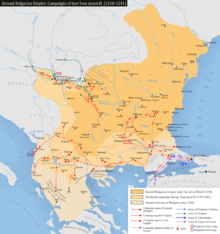Transdanubian Bulgaria
Transdanubian Bulgaria (Bulgarian: Отвъддунавска България) is a term in Bulgarian historiography referring to the countries north of the Danube, which at the time of the First and Second Bulgarian Empire were in the possession or administrative-economic and vassal subordination of the Bulgarian monarchs.[1]
These are mainly the countries of present-day Romania, as well as countries from Hungary, Moldova, Ukraine and Serbia - Vojvodina. During the second Bulgarian Empire, until the gradual formation of independent Wallachian and Moldavian principalities, their countries were part of the political geography of Bulgaria, and these countries were administratively and economically organized as Bulgarian regions. However, even after the beginning of the rule of the first Vlach rulers of Basarab, these territories remained under Bulgarian influence.[2]
The Middle Bulgarian language was official and used in Wallachia and Moldova until the end of the 17th century - from the Battle of Hopleja (1655) to the beginning of the rule of the Phanariots (1711-1715). The beginning of the so-called re-romanization was marked by the release of the Bucharest Bible and the Treaty of Karlowitz.
References
See also
- Vlach-Bulgarian royal charters
- Hrizică
- Rebellion of the Seimens and Home Guard
- First Romanian School
- Romanian Cyrillic alphabet
- History of Dobruja

